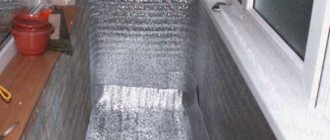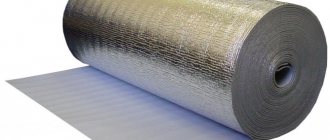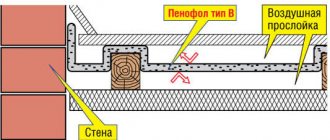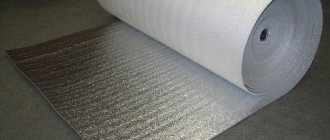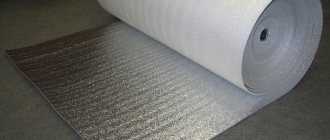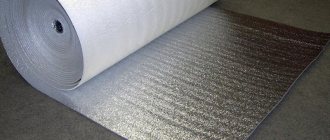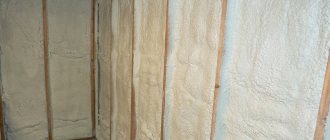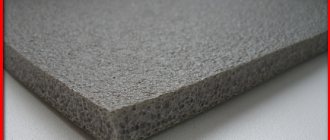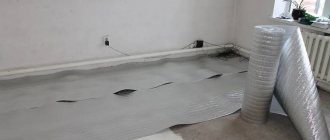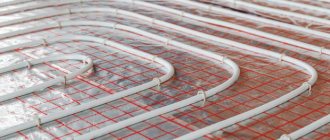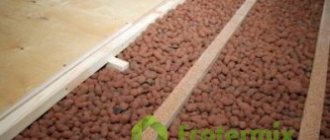Raw material base and method of production of thermal insulation Tepofol
Tepofol is an innovative thermal insulation material made from non-crosslinked polyethylene foam (NPE). The raw material for thermal insulation is one of the most popular polymers of our time, polyethylene (PE), and more specifically, granulated high-density polyethylene (HDPE). The same raw materials are used in the production of containers for the food industry, as well as for almost all other areas of our life. Polyethylene granules are melted, isobutane is introduced into the melt, which provokes foaming of the mass, and the foamy mass is pressed through an extruder.
The closed porous structure provides insulation with not only minimal thermal conductivity, but also hydrophobicity.
Foamed polyethylene has been used for quite a long time, but Tepofol is an innovative product, since it is the first time that a sheet of such thickness has been produced with patented interlocking connections. Unlike similar insulators, it can be used independently, without the need for combination with other materials. That is, instead of the traditional multi-layer “pie” - one sheet.
To improve the heat-insulating properties of foamed polyethylene, the fabric is covered with a heat-reflecting film on one or both sides. An innovation is the use of only lavsan film on the Tepofol line of main thermal insulation - unlike aluminum foil, this coating is elastic, inert to moisture and does not shield mobile communications signals.
One of the reasons for increased heat loss in buildings is the temperature bridge (cold bridge) - a section of the building envelope that has a reduced temperature resistance.
The insulation production technology makes it possible to completely eliminate cold bridges during the insulation process thanks to the interlocking connection. During the installation process, the locking joints are processed using a construction hair dryer, the canvas is “welded” at the molecular level, forming a solid, hermetic coating.
Some other thermal insulation materials also have locks, but they either remain “open” and allow heat to pass through the joints.
Or they foam, but in this case the strength and reliability of the connection is not comparable to a welded seam.
Characteristics and advantages of the material
Polyethylene, used everywhere, including as food packaging, is an environmentally friendly substance. Tepofol, made from polyethylene, is also a completely safe material that does not release toxic substances into the environment. Considering how things are with the environment not only outside, but also inside our homes, this is one of the most important parameters. The technical characteristics of the material are also excellent:
- Low thermal conductivity - 0.028-0.039 W/(m*C) (the best indicator with a double-sided heat-reflecting layer - Tepofol B);
- Minimum water absorption – up to 0.96% (of volume, with full immersion for 28 days);
- Density – 16-25 kg/m³;
- Strength – from 16 kPa (for compression at linear deformation of 10%);
- Strength – 81.55 kPa (longitudinal tensile);
- Impact noise insulation – from 24 dB (with a sheet thickness of 10 mm);
- Biological resistance - does not rot, is not affected by microorganisms, as for pests, mice eat, in principle, everything, but they do not show much interest in NPE (and if there is a problem with rodents, it is solved not by insulation, but by the use of specialized means and measures );
- Durability - subject to storage conditions and installation technology, the service life of the insulation is not limited;
- Easy installation - screws and rondole washers, or on plastic dowels, without membranes and foam (they also do without protective equipment, since no suspension is released during cutting and installation).
Features of penofol: properties and characteristics
Penofol has a wide range of uses. It is used for residential and non-residential buildings, making cladding both inside and outside. This popularity is due to the excellent technical characteristics of the material.
Properties of penofol:
- It has a small thickness. The maximum value for this indicator is 1 cm. This directly affects the cost of the product. For interior work, the optimal thickness is 5-7 mm.
- The thermal conductivity of a foil insulator is difficult to calculate. Typically, heat transfer resistance is used. For double-sided foam foam with a thickness of 5 mm, the resistance is 1.23 m 2 / S / Watt. When using mineral wool, this indicator can only be achieved with a material thickness of 8 cm.
- Penofol does not allow moisture to pass through.
- The material provides sound insulation. To improve this indicator, all joints will need to be sealed.
- Due to its excellent vapor barrier properties, there is no need to install a corresponding layer.
Penofol is resistant to the negative effects of the external environment. So the material can be used at temperatures up to 100 degrees. It is environmentally friendly, not harmful to health, and resistant to chemicals. Manufacturers talk about the durability of penofol, but this information is not confirmed by research.
Installation of penofol does not require the installation of a vapor barrier layer.
The material is difficult to ignite and does not spread flame. This allows the use of penofol in different buildings. With its help you can reduce heat loss in the room.
Scope of application and vapor permeability
The material is elastic, lightweight, suitable for structures of the most complex shapes and truly universal - it can be used in almost all areas of our life. But, since we are talking about home insulation, let’s consider this particular specialization.
- Insulation of walls - both outside and inside.
- Insulation of roofs with cold attics and attics.
- Insulation of floors, including interfloor ones.
- Insulation of glazed balconies and loggias.
- Insulation of foundations.
- Floor insulation.
This insulator can be used for various reasons; it is combined with any technology, including frame technology. But, as usual lately, the question immediately arises about vapor permeability, taking into account the “breathing” of the walls.
I don’t quite understand how a house can be insulated with Tepofol. Where will the steam go?
Using foiled thermofol: characteristics and advantages
Teplofol is a polyethylene foam. The thickness of the material is small, and the outer covering is made of foil. The scope of application of insulation is varied. When using pipe lining, tepofor prevents the formation of condensation.
Characteristics of thermofol:
- Able to withstand temperatures from 80 to 105 degrees;
- Has 97% radiation reflection;
- Low vapor permeability;
- Weight is 44 kg per 1 m3.
The material has many advantages. They note its small thickness and high efficiency. Thermofol is quite flexible and easy to install. The insulation can be attached directly to the wall using tape or a stapler. It is compatible with most building materials.
Thanks to foil thermal insulation, you can significantly improve the thermal insulation qualities of any room
Teplofol is not the main insulation; it is used in combination with other heating. In addition, you will have to equip ventilation.
Thermofol is used for all surfaces. Moreover, it is not only insulation, but also sound insulation. The material is durable, moisture-resistant, environmentally friendly and inexpensive.
Penofol
About the manufacturer
Penofol is a brand produced by LIT Plant, which was founded in 1979. The company was the first in Russia to begin applying a reflective layer of foil to the surface of foamed polyethylene. Thanks to this fact, the Penofol trademark is widely known in the Russian market.
Very often, the consumer calls penofol any insulation made of foamed polyethylene with a reflective surface. And this despite the fact that in Russia there are about 30 similar manufacturers with their own brands.
The main activities of the enterprise are:
- production of energy-saving materials based on polished aluminum foil, operating on the principle of reflecting heat flow (reflective thermal insulation), intended for insulation of enclosing structures of residential and industrial buildings;
- production of materials from foamed polyethylene intended for technical thermal insulation of heating and water supply, ventilation and air conditioning systems, for use in “warm floor” systems, as well as for protecting thermal insulation from mechanical damage, atmospheric influences and ultraviolet radiation.
The company is successfully developing and producing products for various purposes under the trademarks: PENOFOL®, TILIT®, ARMOFOL®, TITANFLEKS®, used in construction.
About products
A distinctive feature of Penofol is its blue color. In principle, only foil is used as a reflective layer. Excellent quality material with an adhesive layer, one of the best on the market, if not the best.
Since 2015, LIT Plant began producing the updated Penofol material with additional protection against counterfeiting - a hologram, which is printed on both sides on polished aluminum foil.
Examples of incorrect and dangerous use of Penofol
- Laying Penfol under a cement (reinforced concrete) screed. The foil is destroyed by the alkaline aggression of concrete, the insulation layer is compressed excessively. There is no warming effect.
- The use of Penofol as the main insulation layer in structures that must be insulated in accordance with standards - in floors, in roofs, in walls. In this case, users are usually guided by the assurances of sellers that the material replaces “5 centimeters of polystyrene foam” or “6 centimeters of mineral wool.” As a result, without a main insulating layer (in most cases, 10 cm of effective insulation is economically optimal...), the structures remain cold.
- Application from the side of the living space directly onto Penofol, without leaving an air gap, finishing panels, wooden finishing, wood structures, which entails dampening of the finishing, mold development, wood rotting due to condensation accumulated on the vapor barrier insulation. After a year of such use, according to the owners, Penofol is “black with mold.”
- Laying inside panel structures along the foil side of the electrical wiring.
- Joining Penofol sheets leaving gaps, which, in addition to a general reduction in insulation, in some structures leaves greater air permeability (drafts), which completely eliminates the presence of an insulating layer.
Tepofol
About the manufacturer
Tepofol is a brand, a registered trademark also belongs to Tepofol LLC. The manufacturing company was founded in 2004 and began its activities by designing and putting into practice a laminator for applying a reflective layer to a polyethylene foam surface.
“Tepofol” is the founder of a completely new thermal insulation material made of non-crosslinked polyethylene foam and seamless insulation technology based on it. Currently, Tepofol is not only the first and leading domestic manufacturer, but also the only company in Russia and in the world in the segment of production of insulation in rolls (thickness over 50 mm) with a patented technology for interlocking the material.
Unlike Penofol, the production company specializes only in foamed polyethylene and products made from it.
About products
A distinctive feature of Tepofol is the edge of the locking connection at the top and bottom of the roll.
Foil or metallized Mylar film is used as a reflective layer. Tepofol is used for basic (20-150 mm) thermal insulation of residential premises and construction sites. Tepofol for additional thermal insulation
Additional thermal insulation (2-10 mm) is used as a supplement to the main insulation when insulating a house structure, as well as in other design solutions for vibration, hydro, and noise insulation of residential premises and construction sites.
Tepofol for basic thermal insulation
Tepofol (20-150 mm) is widely used as the main and only (without insulating membranes) thermal insulation instead of traditional types of insulation (foam plastic, mineral wool, expanded polystyrene, etc.). Insulation of an object based on Tepofol and seamless technology is simple, easy to install, reliable, and does not require replacement for many years. Not only foil is used as a reflective layer, but also metallized lavsan film is used for use in a humid environment to avoid corrosion of the foil.
In addition to the production of thermal insulation material, we have extensive practical experience in insulating various objects, on the basis of which unique technologies have been developed and patented that guarantee high insulation results for many years, namely:
- insulation of industrial buildings, warehouses, hangars (frame, frameless, tent);
- insulation of private residential premises (walls, roofs, floors, foundations, attics) and frame houses;
- insulation of balconies, loggias;
- thermal insulation of sports facilities, including facilities where it is necessary to maintain snow or ice cover;
- insulation of objects in the Arctic zone;
- and others.
Tepofol NPE - polyethylene foam (backing)
| Name | Thickness | Dimensions | Square | Photo | Price per m2 |
| NPE substrate 2mm | 2mm | 1.05mx50m | 52.5m2 | Photo | 7 |
| NPE substrate 3mm | 3mm | 1.05mx50m | 52.5m2 | Photo | 9,5 |
| NPE substrate 4mm | 4mm | 1.05mx50m | 52.5m2 | Photo | 13 |
| NPE substrate 5mm | 5mm | 1.05mx50m | 52.5m2 | Photo | 16 |
| NPE substrate 8mm | 8mm | 1.05mx25m | 26.25m2 | Photo | 27 |
| NPE substrate 10mm | 10mm | 1.05mx25m | 26.25m2 | Photo | 31 |
| substrate 15mm | 15mm | 1.05mx25m | 26.25m2 | Photo | 85 |
| NPE substrate 20mm | 20mm | 1.05mx25m | 26.25m2 | Photo | 100 |
| NPE substrate 30mm | 30mm | 1mx2m | 2m2 | Photo | 155 |
| NPE substrate 40mm | 40mm | 1mx2m | 2m2 | Photo | 200 |
| NPE substrate 50mm | 50mm | 1mx2m | 2m2 | Photo | 245 |
| NPE substrate 100mm | 100mm | 1mx2m | 2m2 | Photo | 520 |
The latest technology for insulating a house with modern material Tepofol! Video editing!
All materials that are marked to order are produced in a maximum of 2-3 days!
Thermal insulation based on polyethylene foam is considered durable thermal insulation that retains all its thermophysical properties for many years. This is a modern and promising insulation based on polyethylene foam; it perfectly performs the functions of heat, hydro, steam and sound insulation. Reflective thermal insulation - has the highest reflectivity, because polished foil has the property of reflecting up to 97% of the radiant component of thermal energy.
This section contains the manufacturer’s general recommendations for the use of thermal insulation in building structures:
Thermal insulation and thermal insulation materials and insulation Thermal insulation of facades and insulation of facades, thermal insulation of walls, insulation of walls, thermal insulation of roofs, thermal insulation of large diameter pipelines (pipe insulation), thermal insulation of floor slabs, heated floors.
Waterproofing and waterproofing materials Foundation waterproofing, waterproofing of any types of roofing, wall waterproofing, basement waterproofing, etc.
Soundproofing and soundproofing materials Car soundproofing, apartment soundproofing, wall soundproofing, wall soundproofing, etc. Soundproofing of premises is a very important factor in construction and decoration. Few soundproofing materials can compare with TEPOFOL.
Vapor barrier and vapor barrier materials In Russian construction there are various types of thermal insulation and waterproofing materials, as well as excellent hydro-vapor barriers of various qualities. NPE is an environmentally friendly material, a super-durable material, an excellent heat insulator, an excellent sound insulator, a lightweight and elastic material, chemically resistant, fireproof. It has a high coefficient of thermal resistance and low weight. We bring to your attention products that meet all requirements and have all the necessary certificates. In addition to thermal insulation properties, these are high-quality steam, hydro and sound insulating materials. Reflective insulation is a composite material. The basis is PPE, NPE, Izolon and other materials made of foamed polyethylene foam coated with aluminum foil or metallized lavsan.
We also offer accessories for installing thermal insulation:
Mounting tape, aluminum tape, metallized tape, etc. Foil materials will never let you down when used in thermal insulation of pipes or soundproofing of an apartment.
We bring to your attention products that meet all requirements and have all the necessary certificates.
Types of insulation (Penoplex, Penofol, Teplofol (Energofol), Basalt wool)
When performing work on insulating balconies and loggias, the Teplozel company works only with proven and certified brands of insulation. Modern Russian manufacturers of insulation materials present a fairly wide range of products. We tried to choose the best options that are best suited for insulating balconies and loggias, light construction residential and domestic structures.
Teplofol, Energofol (fabricated heat insulator based on foamed polyethylene)
The material is made on the basis of foamed polyethylene, covered with polished aluminum foil. Theplofol, due to the foiled film and small polyethylene cell, reflects more than 90% of the heat. This material is intended for both internal and external thermal insulation, vapor barrier, sound insulation, waterproofing, and reduction of room heat loss.
Comparative characteristics for various types of insulation to provide heat transfer resistance
(R)=1.2m2°С/W, at t=40°C (tн=-20°C, tв=+20°С)
Izolon, Penolon (foil insulator based on foamed polyethylene)
It is a chemically or physically cross-linked polyolefin foam, a thermal insulation material made from cross-linked polyethylene foam. Penolon is used as thermal insulation, sound insulation, moisture insulation and vapor barrier; it is ideal for insulating balconies or loggias. Unlike fiberglass materials, it does not tend to compact during long-term use. It does not generate dust and does not emit harmful substances at all.
The mesh, porous structure of Penolon allows the pore walls of the material to have stable, stable strength and elasticity. The pores do not collapse or deform under load, while other types of materials are subject to irreversible loss of elasticity associated with the destruction of the pore walls.
In appearance, Penolon is an elastic, almost white with a noticeable yellowish tint (or gray) material up to 2 m wide (usually 1.5 m), thickness from 4 mm to 15 mm - in rolls, from 20 mm and thicker - in sheets, usually 1 m x 2 m. The structure is closed-porous, the material is geometrically smooth. The pore size is difficult to discern by eye (less than 1 mm), the surface is slightly rough.
Comparative characteristics for various types of insulation with the same heat transfer resistance.
